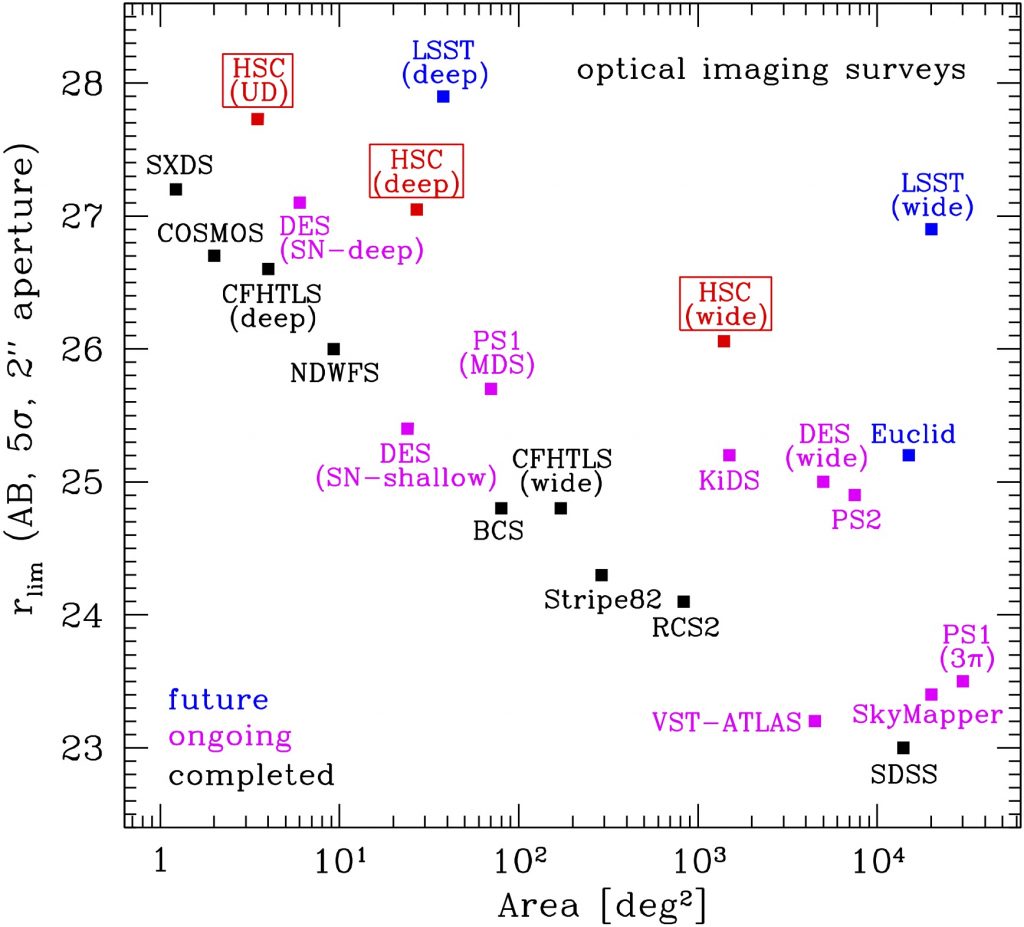Weak gravitational lensing, the tiny distortions in background galaxy shapes, sizes, and fluxes due to the deflection by mass in more nearby objects, is a powerful probe of dark matter and dark energy. Due to its sensitivity to all mass (including dark matter), it can be used to study the dark matter distributions in galaxies and galaxy clusters. A statistical study of the growth of structure with time can also be used to constrain the properties of dark energy, which modifies the growth rate of structure at late times. Finally, weak lensing can be used to constrain theories of modified gravity and test Einstein’s General Relativity on cosmological scales. The HSC weak lensing group plans a comprehensive study of weak lensing that can address all three of these scientific questions.
Why HSC?
At the time HSC survey started, the largest weak lensing survey with depth that enabled studies beyond z~0.5 was CFHTLenS, which observed an ~170 square degree sky area with the limiting magnitude of i~25. The HSC-Wide survey will take images 1 magnitude deeper than CFHTLenS over an area nearly ten times as large. However, what makes the HSC really unique is its superb image quality. The instrument is carefully designed to deliver an instrumental PSF size of better than 0.2″ FWHM over the entire field-of-view. For weak lensing analysis, we will use i-band images, which are taken with seeing better than 0.7″ FWHM. This leads to a high galaxy number density of ~30 per square arcminute with accurate shape measurements. HSC is the deepest of the ongoing weak lensing surveys.

HSC weak lensing science in more detail
Cosmic shear tomography, the correlation of galaxy shapes in redshift slices, is one of the best ways to measure the growth rate of structure and therefore constrain cosmology. The left plot below illustrates the expected cosmic shear auto-correlation signals in three redshift slices, giving a total S/N of ~140 when going up to a multipole of 2000. Compared to the wider but shallower Dark Energy Survey (DES), the HSC survey will have greater S/N at higher redshift, enabling a better measurement of the equation-of-state of dark energy at higher redshift (right plot below):


However, the HSC survey overlaps in its entirety with the SDSS-III BOSS spectroscopic survey. The use of a spectroscopic galaxy sample as lenses in a galaxy-galaxy lensing measurement, combined with their galaxy clustering amplitude, is another approach to constraining cosmological parameters. We will take advantage of this overlapping spectroscopic dataset to carry out this measurement in combination with cosmic shear, enabling maximal cosmological constraining power and reduced sensitivity to systematics.
Finally, we will use galaxy-galaxy and cluster-galaxy lensing in HSC to study the relationship between the observed stellar content of galaxies and clusters and the underlying dark matter in these structures. The galaxy studies will largely build on and extend previous results in surveys such as the SDSS, COSMOS, and CFHTLenS, while the cluster studies will build on those surveys along with previous results from Subaru Suprime-Cam. We will also use our overlap with the ACTPol survey for a more thorough study of cluster properties including the Sunyaev-Zeldovich (SZ) effect.
Shear Estimation, Systematic Tests and Photometric Redshifts
For galaxy shape measurement, we currently use the re-Gaussianization method, which measures moments of galaxy images by treating the non-Gaussianity of the PSF perturbatively (see Hirata & Seljak 2003 for details). This method was used for measuring galaxy shapes in SDSS, and thus systematic uncertainties were already studied comprehensively. We are currently implementing more recent shape measurement methods such as ellipticity of re-smeared artificial image (ERA; Okura & Futamase, 2014), and the Bayesian Fourier domain shear estimation method (BFD; Bernstein & Armstrong, 2014). We carry out a comprehensive set of systematics tests to estimate and control for PSF modeling errors, shear systematics, selection effects, and more. For some of these tests, we have systematics pipelines (Stile and a fake object pipeline that injects fake objects into real HSC data) that help automate this process.
We are also working with the HSC photometric redshift working group to ensure that we have well-understood redshift estimates for background source galaxies.
